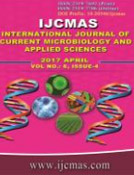


 National Academy of Agricultural Sciences (NAAS)
National Academy of Agricultural Sciences (NAAS)

|
PRINT ISSN : 2319-7692
Online ISSN : 2319-7706 Issues : 12 per year Publisher : Excellent Publishers Email : editorijcmas@gmail.com / submit@ijcmas.com Editor-in-chief: Dr.M.Prakash Index Copernicus ICV 2018: 95.39 NAAS RATING 2020: 5.38 |
This study aimed to get chitinolytic bacteria derived from shell Anadara granosa which has ability to inhibit growth of pathogenic fungi Fusarium sp. and Rhizoctonia solani. Shell samples taken from Paoterearea then isolated on an agar medium chitin, colonies that grow and establish a clear zone chitinolytic bacterial isolates. Chitinolytic bacteria grow and form a clear zone. Result of bacterial isolation obtained eight of chitinolytic bacteria i.e., IK-A, IK-B, IK-C, IK-D, IK-E, IK-F, IK-G, IK-H. Based on test inhibitory effect on pathogenic fungi Rhizoctonia solani, IK-A bacterial isolates showed the greatest inhibition by 1.21 cm while the smallest inhibitory i.e., IK-H with 0.70 cm at 1x24 hours incubation. While the fungal pathogen Fusarium sp. of eight isolates of bacteria, none of which showed positive results. Then made macroscopic observations by looking at colony (shape, elevation and ledges), microscopic (gram staining) and biochemical test (Motility, MR, VP, TSIA).
 |
 |
 |
 |
 |